Twilight of the Middle Ages
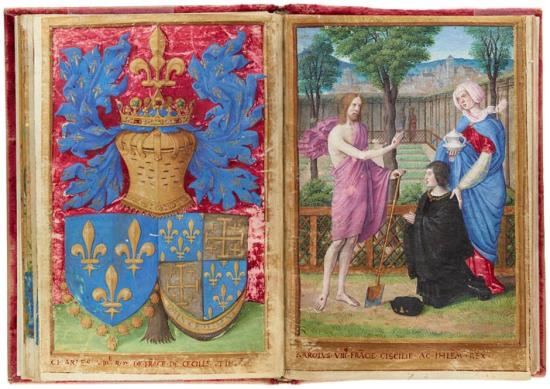
Bifolio inserted into a Book of Hours
Illuminated by Jean Poyer
Purchased by Pierpont Morgan, 1907
King Charles VIII in a New Look
The heraldry — which calls Charles VIII king of France, Sicily, and Jerusalem — dates this image of the kneeling monarch to the short period in which he ruled (at least titularly) those two far-flung realms. Charles wears a new garment, the sayon, a man's outer coat, often of luxurious cloth, with a fitted waist and a many-gored skirt. Its huge sleeves are typical of the 1490s. He is shod in new pantoffles, round-toed slippers (often with open backs). Before him lies the new carmignolle, a man's hat with a low crown and a divided brim held up by laces (of which the gold aglets are visible).
Twilight of the Middle Ages
This was a period of transition in northern Europe—the Middle Ages were not yet over, and the Renaissance had not yet begun. Both King Charles VIII and Louis XII invaded Italy, and these military campaigns exposed France to Italian art, culture, and fashion. At the same time, the Late Gothic style still dominated the arts—and clothing—of northern Europe. Fashions of this period reflect these conflicts.
In the 1480s, the look for men changed abruptly. Padded shoulders and the V-shaped silhouette disappeared. Long loose open gowns came into style and, by the 1490s, these gowns became especially voluminous and bulky. Round-toed shoes replaced the pointy pouleines. New, however, and probably reflecting Italian influence, were the man's outer coat called a sayon, the man's hat called a carmignolle, and doublets with slit sleeves through which the linen of the shirt protruded.
Women's gowns of this period also became fuller, and bombard sleeves were revived. The neck got square. The turret disappeared, while its frontlet remained, now attached to a new small-crowned coif.
Death Takes a Knight
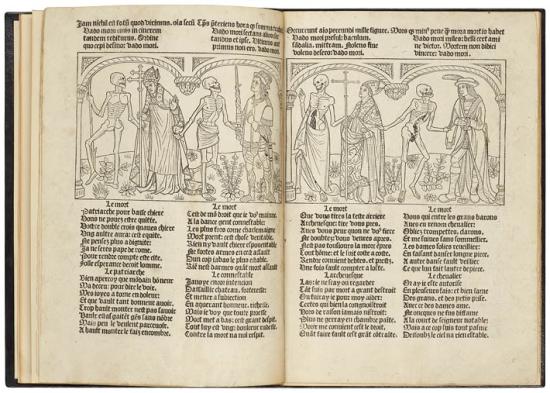
Dance of Death, in French
Woodcuts designed by the Master of the Chronique scandaleuse(?)
Purchased, 1975
For our purposes, we can ignore the patriarch, the constable, and the archbishop (Death's first three victims) and concentrate on the knight at the far right. His gown has the new look of the 1480s. Open, with wide lapels, it is long, loose, and, lacking the pleats of the previous decades, hides, rather than highlights, the male form. Gone, too, are the flattering padded shoulders. His hat, with its low crown and brim, is also new, as are his shoes. These are the demy pantouffles, round-toed slippers with an open back.
Twilight of the Middle Ages
This was a period of transition in northern Europe—the Middle Ages were not yet over, and the Renaissance had not yet begun. Both King Charles VIII and Louis XII invaded Italy, and these military campaigns exposed France to Italian art, culture, and fashion. At the same time, the Late Gothic style still dominated the arts—and clothing—of northern Europe. Fashions of this period reflect these conflicts.
In the 1480s, the look for men changed abruptly. Padded shoulders and the V-shaped silhouette disappeared. Long loose open gowns came into style and, by the 1490s, these gowns became especially voluminous and bulky. Round-toed shoes replaced the pointy pouleines. New, however, and probably reflecting Italian influence, were the man's outer coat called a sayon, the man's hat called a carmignolle, and doublets with slit sleeves through which the linen of the shirt protruded.
Women's gowns of this period also became fuller, and bombard sleeves were revived. The neck got square. The turret disappeared, while its frontlet remained, now attached to a new small-crowned coif.
New Trends Reflected in a Bishop's Prayer Book
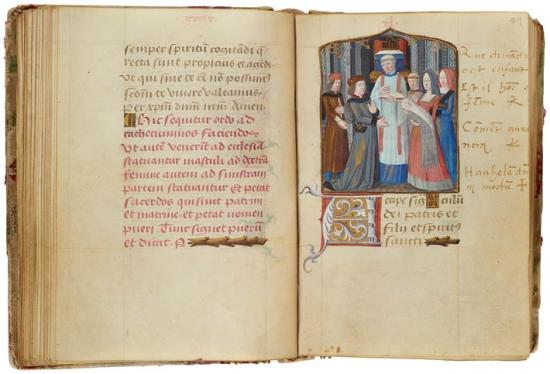
Pontifical, in Latin
Illuminated by the Master of Cardinal de Bourbon
Purchased by Pierpont Morgan, 1908
The baptismal rite in this Pontifical (a liturgical service book used by a bishop) is illustrated by a baptism scene with people dressed in contemporaneous fashions. Thus the godfather in gray and, behind him, the father in brown wear the gown of the 1480s that is loose, without the flaring pleats popular during the previous decades. They both wear a hat with a low crown and a divided, upturned brim. Slung across each man's chest is a black cornet, which is attached to a fur hat falling down the back. The pink gown of the godmother has a new square neck.
Twilight of the Middle Ages
This was a period of transition in northern Europe—the Middle Ages were not yet over, and the Renaissance had not yet begun. Both King Charles VIII and Louis XII invaded Italy, and these military campaigns exposed France to Italian art, culture, and fashion. At the same time, the Late Gothic style still dominated the arts—and clothing—of northern Europe. Fashions of this period reflect these conflicts.
In the 1480s, the look for men changed abruptly. Padded shoulders and the V-shaped silhouette disappeared. Long loose open gowns came into style and, by the 1490s, these gowns became especially voluminous and bulky. Round-toed shoes replaced the pointy pouleines. New, however, and probably reflecting Italian influence, were the man's outer coat called a sayon, the man's hat called a carmignolle, and doublets with slit sleeves through which the linen of the shirt protruded.
Women's gowns of this period also became fuller, and bombard sleeves were revived. The neck got square. The turret disappeared, while its frontlet remained, now attached to a new small-crowned coif.
Striped Hose and Double Hats
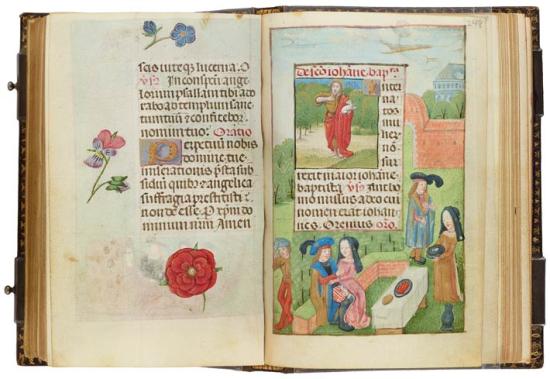
Book of Hours, in Latin
Bequest of E. Clark Stillman, 1995
In addition to the flowers strewn on most of its leaves, this tiny prayer book also contains numerous borders historiated with people dressed in contemporaneous clothing. The two foppishly dressed men shown here wear the new loose calf-length gown with wide lapels and long slit sleeves. Each man also wears two hats: a large wide-brimmed version, with an ostrich feather, worn atilt over a small cap. The seated youth wears the new stocks divided into lower and upper hose (here the upper hose — the boulevars — are striped). The women wear a new low-crowned coif with wide frontlet.
Twilight of the Middle Ages
This was a period of transition in northern Europe—the Middle Ages were not yet over, and the Renaissance had not yet begun. Both King Charles VIII and Louis XII invaded Italy, and these military campaigns exposed France to Italian art, culture, and fashion. At the same time, the Late Gothic style still dominated the arts—and clothing—of northern Europe. Fashions of this period reflect these conflicts.
In the 1480s, the look for men changed abruptly. Padded shoulders and the V-shaped silhouette disappeared. Long loose open gowns came into style and, by the 1490s, these gowns became especially voluminous and bulky. Round-toed shoes replaced the pointy pouleines. New, however, and probably reflecting Italian influence, were the man's outer coat called a sayon, the man's hat called a carmignolle, and doublets with slit sleeves through which the linen of the shirt protruded.
Women's gowns of this period also became fuller, and bombard sleeves were revived. The neck got square. The turret disappeared, while its frontlet remained, now attached to a new small-crowned coif.
Portraits in Prayer Books
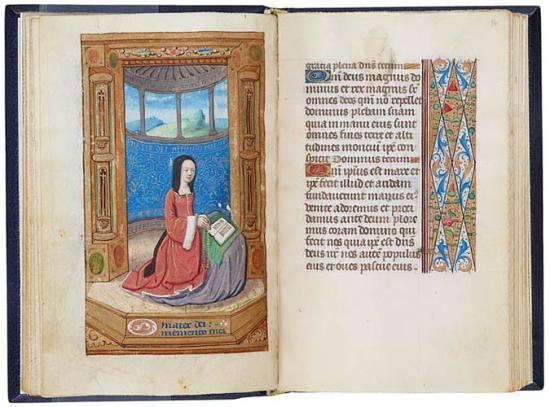
Book of Hours, in Latin and French
Purchased by Pierpont Morgan, 1909
Men and women who specially commissioned Books of Hours often asked that their portraits be included. The woman portrayed here originally faced an image of the Virgin Mary, which has since gone astray. Her fur-lined gown has the new square neck and small bombard sleeves. Her headgear is the new small-crowned coif with wide frontlet and an unusually long cornet trailing down her back. She prays from a rosary and a Book of Hours, the loose green chemise binding of which spreads like a place mat over the prie-dieu.
Twilight of the Middle Ages
This was a period of transition in northern Europe—the Middle Ages were not yet over, and the Renaissance had not yet begun. Both King Charles VIII and Louis XII invaded Italy, and these military campaigns exposed France to Italian art, culture, and fashion. At the same time, the Late Gothic style still dominated the arts—and clothing—of northern Europe. Fashions of this period reflect these conflicts.
In the 1480s, the look for men changed abruptly. Padded shoulders and the V-shaped silhouette disappeared. Long loose open gowns came into style and, by the 1490s, these gowns became especially voluminous and bulky. Round-toed shoes replaced the pointy pouleines. New, however, and probably reflecting Italian influence, were the man's outer coat called a sayon, the man's hat called a carmignolle, and doublets with slit sleeves through which the linen of the shirt protruded.
Women's gowns of this period also became fuller, and bombard sleeves were revived. The neck got square. The turret disappeared, while its frontlet remained, now attached to a new small-crowned coif.
A Fop Goes Hawking (Part 2)
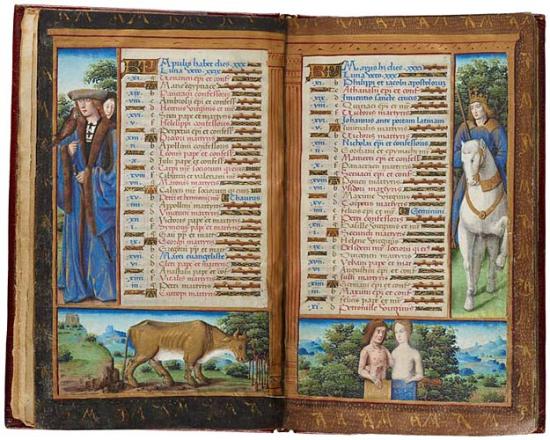
Book of Hours, in Latin
Illuminated by the Master of Petrarch's Triumphs
Purchased by J. P. Morgan, Jr., 1906
As seen elsewhere in this exhibition, medieval calendars can be great sources for representations of contemporaneous clothing. In this prayer book it is the month of April that is illustrated by a fashionably dressed young man with a falcon on his wrist. He wears a very luxurious fur-lined full-length gown with wide lapels and large, open sleeves. His doublet is open at his chest, revealing, below knotted ties, a linen shirt. His wide hat has an upturned brim. Below the man is April's zodiacal sign of Taurus. On the right, May is illustrated by a mounted king and the sign of Gemini.
Twilight of the Middle Ages
This was a period of transition in northern Europe—the Middle Ages were not yet over, and the Renaissance had not yet begun. Both King Charles VIII and Louis XII invaded Italy, and these military campaigns exposed France to Italian art, culture, and fashion. At the same time, the Late Gothic style still dominated the arts—and clothing—of northern Europe. Fashions of this period reflect these conflicts.
In the 1480s, the look for men changed abruptly. Padded shoulders and the V-shaped silhouette disappeared. Long loose open gowns came into style and, by the 1490s, these gowns became especially voluminous and bulky. Round-toed shoes replaced the pointy pouleines. New, however, and probably reflecting Italian influence, were the man's outer coat called a sayon, the man's hat called a carmignolle, and doublets with slit sleeves through which the linen of the shirt protruded.
Women's gowns of this period also became fuller, and bombard sleeves were revived. The neck got square. The turret disappeared, while its frontlet remained, now attached to a new small-crowned coif.
Clothing Reflects Character and Status
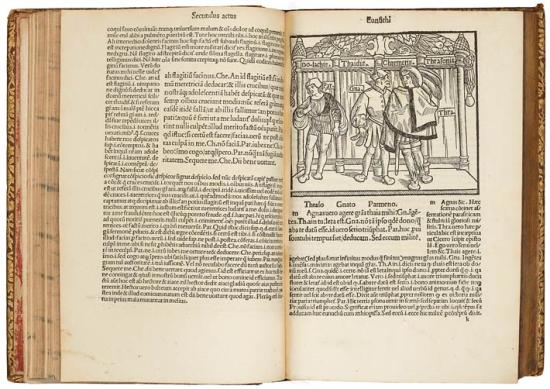
Comedies, in Latin
Woodcuts designed by the Master of the Club Feet, printed by Johannes Trechsel
Purchased by Pierpont Morgan, 1902
Clothing reflects the moral nature and social standing of the characters in this edition of Roman playwright Terence's Comoediæ. In this woodcut from "The Eunuch," for example, Thraso, the protagonist's rival, is dressed very foppishly. He wears a brimmed hat with multiple ostrich feathers and a cape with a striking black border. His boots are slashed at the ankle. The gown of his servant, Gnato, has an outlandishly dagged hem, symbolic of his parasitic personality. Parmeno, the protagonist's faithful servant, wears fashionable stocks with striped boulevars and a simple doublet. His linen shirt is visible at the doublet's open chest and cascades from its slit sleeves.
Twilight of the Middle Ages
This was a period of transition in northern Europe—the Middle Ages were not yet over, and the Renaissance had not yet begun. Both King Charles VIII and Louis XII invaded Italy, and these military campaigns exposed France to Italian art, culture, and fashion. At the same time, the Late Gothic style still dominated the arts—and clothing—of northern Europe. Fashions of this period reflect these conflicts.
In the 1480s, the look for men changed abruptly. Padded shoulders and the V-shaped silhouette disappeared. Long loose open gowns came into style and, by the 1490s, these gowns became especially voluminous and bulky. Round-toed shoes replaced the pointy pouleines. New, however, and probably reflecting Italian influence, were the man's outer coat called a sayon, the man's hat called a carmignolle, and doublets with slit sleeves through which the linen of the shirt protruded.
Women's gowns of this period also became fuller, and bombard sleeves were revived. The neck got square. The turret disappeared, while its frontlet remained, now attached to a new small-crowned coif.
Young Love in the Spring (Part 1)
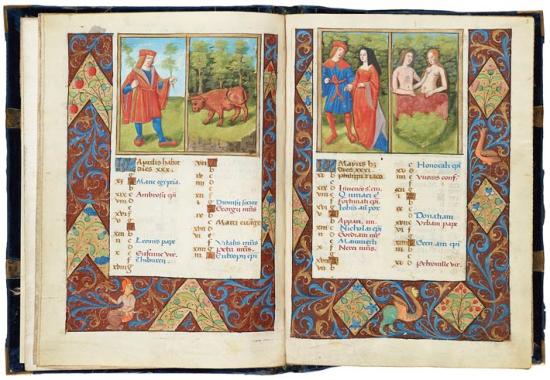
Psalter, in Latin and French
Illuminated by the Master of Philippe of Guelders and the Master of Jacques de Besançon
Bequest of Herbert H. Lehman, 1968
The young man carrying branches during the month of April wears the new sayon, the man's outer coat with a fitted waist and a many-gored skirt. Its large, slit sleeves are typical of the 1490s. On his head is the new carmignolle, the man's hat with a low crown and a divided, upturned brim, and on his feet are the new pantoffles, round-toed slippers. The man courting in May is similarly dressed, although his sayon has a wide collar instead of lapels. His girlfriend's gown features the period's square neck and small bombard sleeves. Her headgear is the coif plus frontlet.
Twilight of the Middle Ages
This was a period of transition in northern Europe—the Middle Ages were not yet over, and the Renaissance had not yet begun. Both King Charles VIII and Louis XII invaded Italy, and these military campaigns exposed France to Italian art, culture, and fashion. At the same time, the Late Gothic style still dominated the arts—and clothing—of northern Europe. Fashions of this period reflect these conflicts.
In the 1480s, the look for men changed abruptly. Padded shoulders and the V-shaped silhouette disappeared. Long loose open gowns came into style and, by the 1490s, these gowns became especially voluminous and bulky. Round-toed shoes replaced the pointy pouleines. New, however, and probably reflecting Italian influence, were the man's outer coat called a sayon, the man's hat called a carmignolle, and doublets with slit sleeves through which the linen of the shirt protruded.
Women's gowns of this period also became fuller, and bombard sleeves were revived. The neck got square. The turret disappeared, while its frontlet remained, now attached to a new small-crowned coif.
Bulkiness Dominates the Look for Men
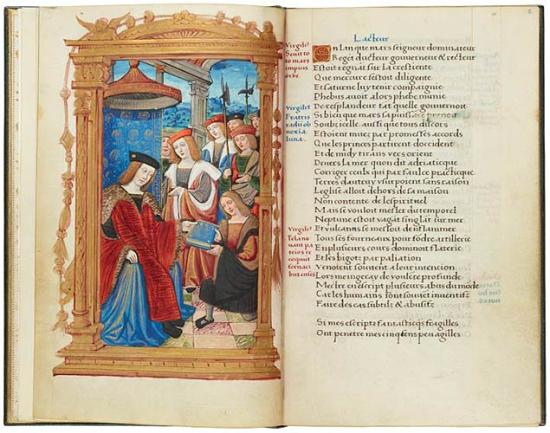
Abuses of the World, in French
Purchased by Pierpont Morgan, 1899
The frontispiece to this copy of Gringore's Les abus du monde, a poem that satirizes all classes of mankind, shows the author presenting a copy of his work to King Louis XII. The seated monarch, the kneeling author, and the courtier standing behind them all wear the loose bulky gown, with a huge collar and open sleeves, that is typical of this period. Even as some Italian influence on French clothing can be seen during this first decade of the sixteenth century, men's fashion in this twilight period was dominated by these large, unflattering garments.
Twilight of the Middle Ages
This was a period of transition in northern Europe—the Middle Ages were not yet over, and the Renaissance had not yet begun. Both King Charles VIII and Louis XII invaded Italy, and these military campaigns exposed France to Italian art, culture, and fashion. At the same time, the Late Gothic style still dominated the arts—and clothing—of northern Europe. Fashions of this period reflect these conflicts.
In the 1480s, the look for men changed abruptly. Padded shoulders and the V-shaped silhouette disappeared. Long loose open gowns came into style and, by the 1490s, these gowns became especially voluminous and bulky. Round-toed shoes replaced the pointy pouleines. New, however, and probably reflecting Italian influence, were the man's outer coat called a sayon, the man's hat called a carmignolle, and doublets with slit sleeves through which the linen of the shirt protruded.
Women's gowns of this period also became fuller, and bombard sleeves were revived. The neck got square. The turret disappeared, while its frontlet remained, now attached to a new small-crowned coif.